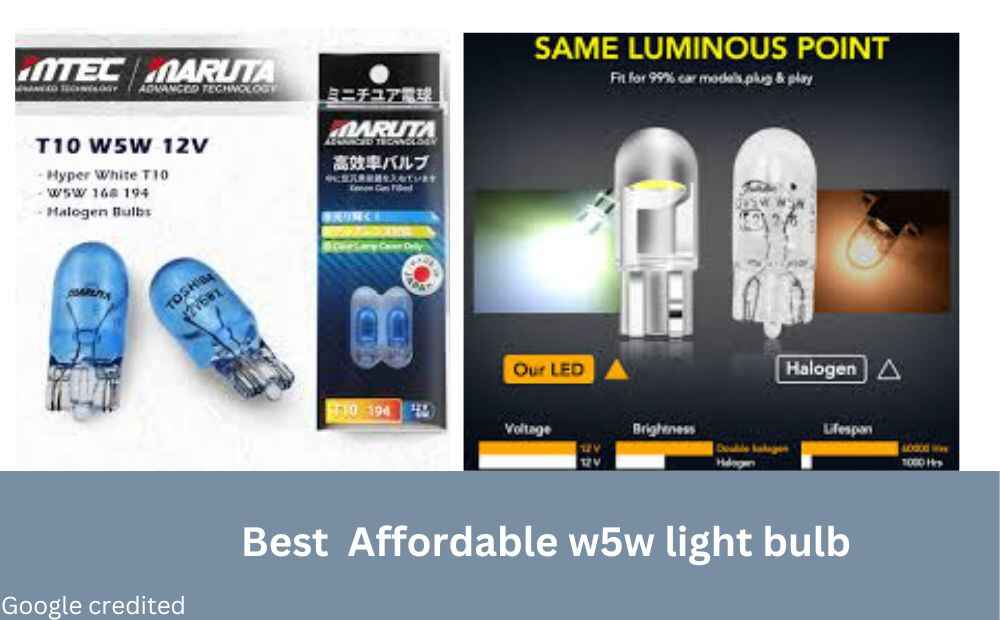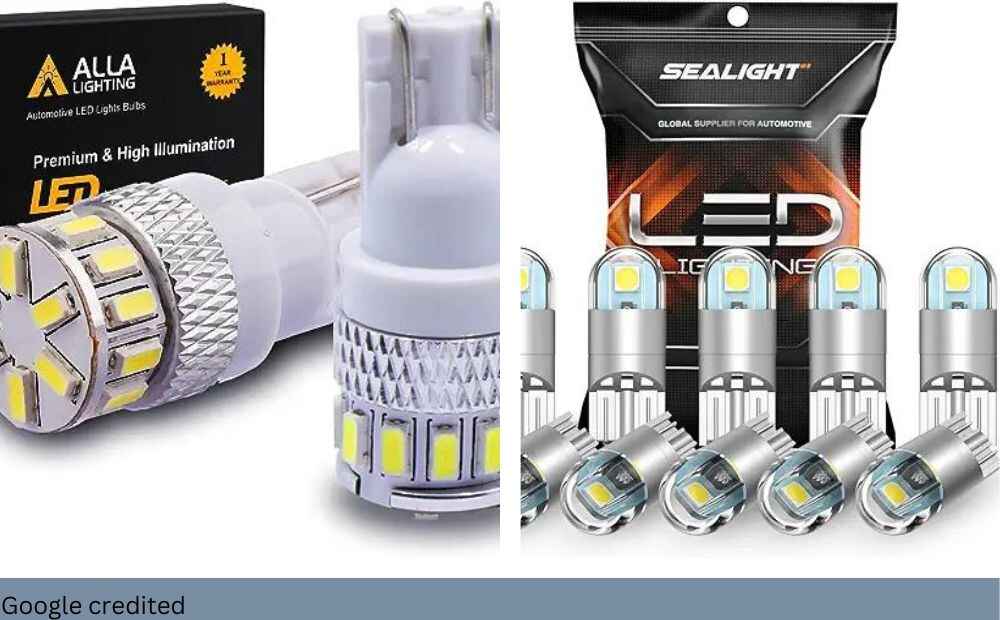Choosing the right bulb for your vehicle can feel confusing, especially when comparing two popular types like W5W vs W6W. Both are commonly used in automotive lighting, but they serve different purposes and have unique characteristics. Whether you’re upgrading your car’s lights or simply replacing a burned-out bulb, this article will guide you through the key differences, applications, and performance of W5W and W6W bulbs.
By the end, you’ll not only understand the differences between these bulbs, but also which one suits your vehicle’s needs best. So, let’s dive into the world of W5W vs W6W bulbs, shedding light on their features and helping you make an informed choice.
Understanding W5W vs W6W Bulbs
1. Definition of W5W Bulbs
W5W bulbs are small wedge base bulbs commonly used in vehicles for various lighting purposes. The “W” stands for “wattage,” and the number “5” refers to its 5-watt power consumption. These bulbs are versatile and often found in parking lights, side markers, and interior lights of vehicles.
2. Definition of W6W Bulbs
Similarly, W6W bulbs are wedge base bulbs, but they consume 6 watts of power, hence the “6” in their name. W6W bulbs are often used in areas where slightly more brightness is needed, like license plate lights and certain turn signals.
3. Brief History and Development of These Bulb Types
Both W5W and W6W bulbs have a long history in the automotive world. Halogen technology was the first to bring these small, compact bulbs into vehicles, providing a reliable light source for interior and exterior lighting. Over time, advancements in LED technology have introduced LED alternatives to these traditional bulbs, offering more energy efficiency and longer lifespans.
4. Common Applications in Vehicles
W5W bulbs are widely used in parking lights, interior cabin lights, and side marker lights. They’re popular for their small size and low energy consumption. W6W bulbs, on the other hand, are used in applications requiring more brightness, like license plate lighting, dashboard illumination, and some turn signal bulbs.
Key Differences Between W5W vs W6W Bulbs
1. Wattage Comparison
The most obvious difference between W5W and W6W bulbs is their wattage. W5W bulbs consume 5 watts, making them energy-efficient and suitable for low-power applications. W6W bulbs consume 6 watts, giving them slightly higher brightness but also a minor increase in energy consumption.
2. Size and Physical Dimensions
Both bulbs share similar physical dimensions due to their wedge base design, making them compatible with many of the same fixtures. However, it’s important to check your vehicle’s manual to ensure compatibility with the specific socket.
3. Base Types and Compatibility
W5W vs W6W bulbs have a wedge base, which is a common base type in automotive lighting. This means they can easily fit into most standard car sockets designed for wedge-based bulbs.
4. Light Output and Luminosity
In terms of light output, W6W bulbs produce slightly more lumens than W5W, giving them an edge in brightness. However, the difference may not always be noticeable in certain applications.
5. Energy Efficiency
While both bulbs are relatively energy-efficient, W5W bulbs consume less power, making them the preferred choice for interior and low-power applications. W6W bulbs, with their higher brightness, consume slightly more power but are still efficient compared to other types of automotive bulbs like halogen.
Applications of W5W Bulbs
1. Common Uses in Modern Vehicles
W5W bulbs are commonly found in interior car lighting, such as cabin lights, dashboard lights, and map lights. They’re also frequently used for exterior lighting like parking lights, side markers, and license plate lights.
2. Specific Car Models That Typically Use W5W Bulbs
Many modern car models, including popular brands like Toyota, Honda, and Ford, use W5W bulbs for their parking lights and interior illumination. These bulbs are favored for their balance between low power consumption and adequate brightness.
3. Advantages of W5W in Certain Applications
W5W bulbs excel in low-light applications where energy efficiency is key. They are perfect for cars that require long-lasting, low-power lighting solutions. Additionally, their small size makes them ideal for tight spaces in modern vehicles.
Applications of W6W Bulbs
1. Typical Uses in Automotive Lighting
W6W bulbs are used in areas where slightly more brightness is needed, such as license plate lights and some turn signals. Their 6-watt power consumption offers more light without a significant increase in energy use.
2. Vehicle Models That Often Require W6W Bulbs
Certain vehicle models, including luxury brands like BMW and Mercedes-Benz, may use W6W bulbs in specific applications such as license plate lights or dashboard illumination.
3. Benefits of W6W in Particular Scenarios
W6W bulbs offer enhanced brightness, making them suitable for situations where better visibility is crucial. For instance, they can improve license plate visibility at night, which is important for safety and compliance with vehicle regulations.
Performance Comparison
1. Brightness Levels
While both W5W and W6W bulbs provide ample brightness for their intended uses, W6W bulbs have a slight edge in brightness due to their higher wattage. However, the difference is minimal and may not be noticeable in all applications.
2. Power Consumption
W5W bulbs are more energy-efficient, consuming just 5 watts of power, while W6W bulbs consume 6 watts. The difference in power consumption is small, but it can add up over time, especially if the lights are used frequently.
3. Heat Generation
Both bulbs generate a low amount of heat due to their small size and wattage. However, W6W bulbs may produce slightly more heat compared to W5W, though this is generally not a concern in typical vehicle applications.
4. Lifespan and Durability
The lifespan of both bulbs is similar, though it can vary depending on the brand and usage. Both halogen and LED versions of these bulbs are available, with LEDs offering significantly longer lifespans.
5. Color Temperature and Light Quality
Both W5W vs W6W bulbs are available in various color temperatures, allowing you to choose between warm and cool lighting depending on your preference and vehicle needs. LED versions offer more options for color temperature and are generally brighter and more efficient than halogen counterparts.
Installation and Replacement Considerations
1. Ease of Installation for Each Bulb Type
Both W5W and W6W bulbs are easy to install due to their wedge base design. They simply slide into the socket, making installation quick and straightforward.
2. Tools Required for Replacement
Replacing either bulb type typically requires no special tools. However, you may need a screwdriver or a trim removal tool to access certain areas, such as the dashboard or license plate lights.
3. Safety Precautions When Changing Bulbs
When replacing bulbs, always ensure the vehicle is turned off and the bulb has cooled down to avoid burns. Additionally, handle the bulbs by the base, as oils from your fingers can damage the glass and reduce the bulb’s lifespan.
4. Compatibility Issues to Watch Out For
While both W5W vs W6W bulbs share similar base designs, it’s essential to check your vehicle’s manual for compatibility. Installing the wrong bulb can lead to poor performance or even damage to the lighting system.
Cost Analysis: W5W vs W6W
i). Average Price Comparison
W5W bulbs are typically more affordable due to their lower wattage and widespread use. W6W bulbs, while slightly more expensive, offer enhanced brightness, making them worth the extra cost for certain applications.
ii). Long-Term Cost Considerations
LED versions of both bulbs are more expensive upfront but provide long-term savings due to their longer lifespan and lower energy consumption. Investing in LEDs can reduce the frequency of replacements and save money in the long run.
iii). Value for Money Assessment
When considering value for money, W5W bulbs are ideal for low-power applications, while W6W bulbs provide better brightness for exterior lighting. Your decision should be based on your spending limit and individual demands.
iv). Factors Affecting Pricing
Factors like brand, bulb type (halogen vs. LED), and quality can affect the price of W5W and W6W bulbs. It’s important to buy from reputable brands to ensure durability and performance.
Environmental Impact and Energy Efficiency
a). Energy Consumption Comparison
W5W bulbs are more energy-efficient due to their lower wattage, making them better for reducing your vehicle’s overall energy consumption. However, W6W bulbs also offer decent energy efficiency, especially when used in LED form.
b). Environmental Friendliness of Each Bulb Type
Both W5W and W6W bulbs can be environmentally friendly if you choose LED versions, which consume less energy and last longer. Halogen bulbs, while still widely used, are less eco-friendly due to their shorter lifespan and higher energy consumption.
c). Recycling and Disposal Considerations
Always dispose of used bulbs properly, as they may contain materials that are harmful to the environment. Many local recycling programs accept automotive bulbs, and some retailers offer recycling services.
d). Future Trends in Automotive Lighting Efficiency
The future of automotive lighting is moving towards smarter, more efficient lighting systems. LED and adaptive headlight technology are gaining popularity, providing brighter and more energy-efficient solutions for vehicle lighting.
Making the Right Choice for Your Vehicle
Factors to Consider When Choosing Between W5W and W6W
When deciding between W5W and W6W bulbs, consider factors like brightness needs, energy consumption, and application. W5W is ideal for interior and low-light applications, while W6W is better for exterior lighting that requires more brightness.
Importance of Checking Your Vehicle’s Manual
Always refer to your vehicle’s manual when choosing bulbs to ensure compatibility and avoid potential issues with installation or performance.
Recommendations for Different Vehicle Lighting Needs
If you’re looking for energy-efficient, low-power bulbs for interior or parking lights, W5W is the way to go. For brighter, more visible exterior lights, W6W offers the extra lumens needed to enhance visibility and safety.
Conclusion:
Whew! We’ve certainly brightened up the subject of W5W vs W6W bulbs, haven’t we? Remember, the best choice between these two depends on your specific vehicle and lighting needs. If in doubt, always refer to the owner’s manual or a specialist. Whether you go for the versatile W5W or the robust W6W, ensuring your vehicle’s lighting is up to par is crucial for safety and performance. So, don’t leave your car in the dark – make an informed decision and light up the road ahead! Have you made your choice? It’s time to shine on!
Related articles:
Hi, I’m Malik Suhail—an SEO expert, web designer, and passionate blogger with 2 years of experience. I specialize in crafting content that is not only informative but also tailored to meet the needs of my readers.
I write about diverse topics, always striving to simplify complex ideas and provide valuable insights that resonate with my audience. Whether it’s about SEO strategies, web design trends, or blogging tips, I am committed to delivering well-researched, practical, and easy-to-understand information.
My mission is to help readers navigate the digital world with confidence and clarity. I believe in adding value through authentic content that inspires action and delivers results.


